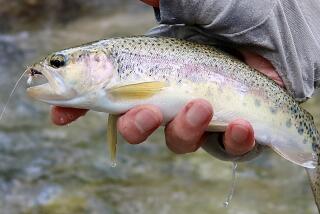Judge Halts Plan to Set Minnow Habitat in Rio Grande
- Share via
ALBUQUERQUE — A federal judge has ordered the U.S. Fish and Wildlife Service to review its designation of a 163-mile stretch of the Rio Grande as a critical habitat for the endangered silvery minnow.
U.S. District Judge Edwin Mechem said in the ruling Wednesday that the federal agency’s designation is to be “set aside as arbitrary and capricious” but added it would remain in operation for four months or until Interior Secretary Bruce Babbitt, who oversees the agency, issues an emergency rule in its place.
During those four months, the Fish and Wildlife Service must issue a more complex Environmental Impact Statement supporting the critical habitat designation or risk losing it, Mechem said.
The judge fell short of permanently striking down the designation, which was demanded by the state and the Middle Rio Grande Conservancy District in separate lawsuits.
Those suits were consolidated with a third filed by Forest Guardians, a Santa Fe-based environmental group, which claimed the Fish and Wildlife Service should have gone further and designated more of the river and its flood plains to fully protect the tiny fish.
A critical habitat designation means agencies have to consult with the Fish and Wildlife Service about any actions they might undertake that could affect the minnow.
Mechem criticized the Fish and Wildlife Service for using “umbrella concepts without an examination of specific or individual facts” to write its rule.
“Certainly in a region perpetually too dry and in a river which commonly loses water for a multitude of uncontrollable reasons, there is not a semblance of logic in assuming that an unspecified . . . amount of water will be available,” Mechem wrote.
He said it is unrealistic to assume that when water is not available it could be taken without economic or other consequences.
Mechem also ordered Fish and Wildlife Service representatives to participate in mediation now being conducted in another case, the Silvery Minnow vs. Martinez.
In that case, environmentalists are contending federal management for the minnow’s protection supersedes all other claims to water from the San Juan-Chama water diversion project.
Tom Bauer, a Fish and Wildlife spokesman, said the agency is disappointed but will comply with Mechem’s ruling. Bauer also said the agency will still comply with the Endangered Species Act and that any resolution will have to involve keeping water in the river.
In June 1999, the Fish and Wildlife Service designated the Rio Grande downstream from the Cochiti Dam to the headwaters of Elephant Butte Reservoir as a critical habitat to protect the silvery minnow, one of only nine remaining native fish in the middle stretch of the river.
The designation angered farmers and state water officials who are worried about irrigating land, especially during dry years when the water must stay in the river to protect the minnow.
Water officials estimated that the critical habitat designation would cost New Mexicans about 9 billion to 32 billion gallons of water annually out of an average 42 billion gallons of river water available for human use.
State Atty. Gen. Patricia Madrid hailed Mechem’s ruling as a “major victory for New Mexico, its farmers, industry and cities.”
“It shows that the economic and other consequences of designating critical habitat can no longer be ignored by the Fish and Wildlife Service,” she said in a statement issued Wednesday.
Subhas Shah, district chief engineer for the Middle Rio Grande Conservancy District, called the ruling “a complete vindication of what the district has argued about--that there is no scientific [basis] for declaring the Middle Rio Grande as critical habitat.”
The district is responsible for irrigation, flood protection and drainage in the region covered by the critical habitat designation.
Such a designation for the silvery minnow “would socially and economically harm the Middle Rio Grande Valley,” he said.
“There is not sufficient water available for the needs of water-right holders, farmers, the city and the fish,” he said.
More to Read
Sign up for Essential California
The most important California stories and recommendations in your inbox every morning.
You may occasionally receive promotional content from the Los Angeles Times.










